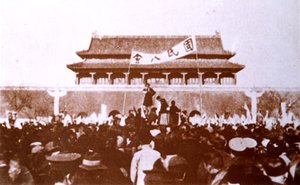May Fourth Movement
|
|
The May Fourth Movement (Template:Zh-cp) was one of the famous anti-foreign movements in China. Some scholars call it "the Chinese Enlightenment." Taking place on May 4, 1919, it marked the beginning of the upsurge of nationalist feeling, with unity of purpose among patriotic Chinese of all classes. The movement grew out of dissatisfaction with the Treaty of Versailles settlement and the effect of the New Cultural Movement.
| Contents |
Background
At home, on one hand, the government of the Northern Warlords yielded to the pressure exerted by the imperialist foreign powers and failed to act in the general interests of the Chinese people. It greatly increased its control of land, industry and mining, resulting in large increases in taxation. This, together with the tangled warfare among warlords which was still continuing led to great suffering among the population. The domestic class contradictions, which were deepening day by day, became the fundamental cause of the outbreak of the May Fourth Movement. On the other hand, during World War I, the national industries developed, the working class rapidly grew in strength, and the workers struggled by frequently going on strike. The development of the New Cultural Movement promoted the emancipation of the mind, and spurred the advanced elements, especially young students, to actively participate in patriotic activities. These prepared the class and ideological foundation for the outbreak of the May Fourth Movement.
The outbreak and course of the May Fourth Movement
In early 1919, the victorious nations of World War I convened a peace conference in Paris. The representatives of the Chinese government put forth the following requests: do away with the privileges of the imperialist countries in China, cancel the "Twenty-One Demands" of the Japanese, take back the privileges in Shandong that Japan had taken from Germany during World War I. Britain and the United States dominated the meeting and rejected the Chinese representatives' demands. The failure in diplomacy of China at the Paris Peace Conference became the incident that touched off the outbreak of the May Fourth Movement.
On May 4th, over 3000 students of Peking University and other schools gathered together in front of Tiananmen and held a demonstration. They shouted out such slogans as "Struggle for the sovereignty externally, get rid of the national traitors at home", "Do away with the 'Twenty-One Demands'", "Don't sign the Versailles Treaty". They demanded with one voice to punish such figures as Cao Rulin, Zhang Zongxiang, and Lu Zongyu, who held important posts as diplomats. The enraged students even burnt Cao Rulin's house. The government of the Northern Warlords suppressed the demonstration and arrested many students.
The next day, students in Beijing as a whole went on strike, and students in other parts of the country responded one after another.
From early June, in order to support the students' struggle, workers and businessmen in Shanghai also went on strike. So did workers in other places one after another. The center of the movement moved from Beijing to Shanghai. The working class went up on the political stage and brought great pressure to bear on the government of the Northern Warlords. The warlords' government had to set free the arrested students and dismiss Cao Rulin, Zhang Zongxiang and Lu Zongyu from their posts. Later, people of the whole China struggled to refuse to sign on the Versailles Treaty. As a result, the Chinese representatives in Paris didn't sign on the peace treaty. The May Fourth Movement won the initial victory.
Historical significance and the New Cultural Movement
The May Fourth Movement was thoroughly an anti-imperialist and anti-feudal revolutionary movement. Young students acted as its pioneers. The Chinese working class went up on the political stage, and functioned as the main force in the later period of the movement. Li Dazhao, Chen Duxiu and other intellectuals directed and promoted the development of the movement, and played leading roles in it.
The May Fourth Movement covered more than 20 provinces and over 100 cities of the country. It had a broader popular foundation than the Revolution of 1911. Its great contribution lay in arousing the people's consciousness and preparing for the unity of the revolutionary forces.
The May Fourth Movement promoted the spreading of Marxism in China, and prepared the ideological foundation for the establishment of the Communist Party of China. The October Revolution pointed out the direction for the Chinese revolution. The May Fourth Movement, which took place after the October Socialist Revolution, was a part of the world's Proletarian Revolution.
The May Fourth Movement marked the beginning of the New Democratic Revolution in China. It also served as a intellectual turning point in China. It was the seminal event that radicalized Chinese intellectual thought. Previously Western style liberal democracy had a degree of traction amongst Chinese intellectuals. However the Versailles Treaty was viewed as a betrayal. Woodrow Wilson's Fourteen Points, cloaked as they were by moralism, were specifically and Western centrist thought more generally seen as hypocritical and was jettisoned by the Chinese intellectual community. The adoption of Marxist/Leninism began to take hold on the left. It was during this time that communism was studied seriously by some Chinese intellectuals such as Chen Duxiu and Li Dazhao.
See also
it:Movimento del 4 maggio 1919 no:4. mai-bevegelsen fi:Toukokuun neljännen päivän liike zh:五四运动

